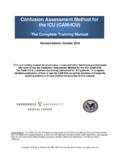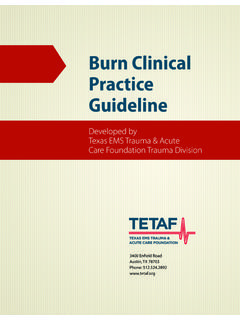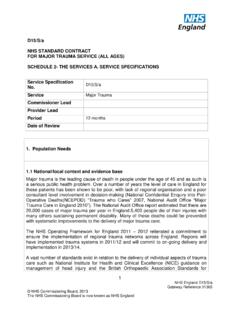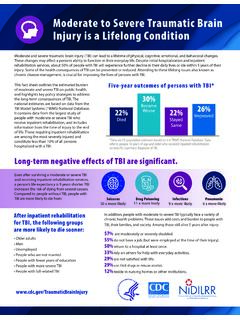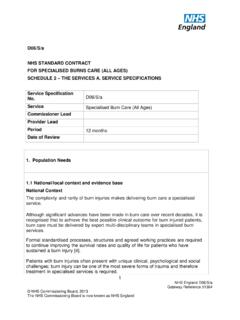Transcription of TETAF Trauma Activation Guidelines
1 TETAF Trauma Activation Guidelines3400 Enfield RoadAustin, TX 78703 Phone: Activation GuidelinesContributorsbrett Dodwell, RN, , CENT omball Regional Medical CenterDavid Golder, RN, Children s Medical Center, AustinAndrea Holmes, RN, , CEN, CCRNM emorial Hermann Southeast hospital , Houstonsherry Jennings, RN, Joseph Regional Health Center, BryanCarolyn Knox, RN, CEN, LPCitizens Medical Center, VictoriaConnie Manley, RN, Regional Medical Center, Brownsville Christi reeves, RN, Clear Lake Regional Medical CenterKathy rodgers, RN, , CNS, CCRN, CENCHRISTUS St. Elizabeth hospital , Beaumontbeth tracy, RN, Palmas Medical Center, El PasoWanda Wiktorik, RNScott & White BrenhamContentThe content for this publication was developed by a TETAF Trauma Division workgroup led by Gina Pickard, RN, Trauma division manager and surgical critical care fellowship coordinator at San Antonio Military Medical Center.
2 Lisa Price, RN, , CEN, Trauma services director at DeTar Health System in Victoria, is chair of the TETAF Trauma Division. Developed by Texas EMS Trauma & Acute care Foundation Trauma DivisionCopyright July 2013 by the Texas EMS Trauma & Acute care Foundation. Individuals may download and print this publication for use within their organization. Other uses including mass copying and distribution of the copyright publication are bybrenda Putz, RN, TETAF , AustinAnn Ward, APR, Strategic CommunicationsDesiGn bybarbara battista, Graphic Design Freelance ServicesPHoto CreDitsp. 4 ..University Health System, San Antoniop. 8 ..Robertson County EMSp. 11 ..University Health System, San Antoniop. 14 ..CHRISTUS St. Elizabeth hospital , Beaumountp. 16 ..Methodist Health System Dallas3 ContentsSECTION 1 Development of the Trauma Team Activation Criteria.
3 4 SECTION 2 Development of the Trauma Team Activation Policy ..5 Levels of Response ..5 Special Considerations ..7 Over- and Under-Triage of Trauma Patients ..8 SECTION 3 Policy Development ..9 SECTION 4 Communication and Education ..10 SECTION 5 Admissions and Transfers ..11 SECTION 6 Monitoring and Evaluation of Trauma Policies ..12 SECTION 7 Summary ..14 SECTION 8 Additional Resources ..15 Links to Additional Resources ..15 Sample Policies ..16 n Scott & White hospital Brenham ..17 n Titus Regional Medical Center, Mount Pleasant ..18, 19, 20 n United Regional Medical Center, Wichita Falls ..21 Information Resources ..22 4 Section 1 Trauma patients require specialized treatment and access to care . Available literature strongly supports the belief that Trauma -related mortality can be reduced through early definitive care delivered via a multidisciplinary approach.
4 Every health care facility with an interest in caring for the injured should evaluate its internal human and facility-based resources and develop a protocol for appropriate multidisciplinary team mobilization. Development of theTrauma Team Activation Criteria5 Section 2 Development of the Trauma Team Activation PolicyBuilding the Trauma Team Activation Policy for hospitals is an internal hospital / Trauma Systems Committee discussion. The primary goal of Trauma team Activation criteria is to ensure that the resources necessary to address the clinical needs of injured patients are immediately available. Protocols for Trauma team Activation should be driven by a number of factors to include defining the most severely injured patients and determining the immediate resource needs to deliver optimal care to the patient.
5 In 1987, the American College of Surgeons released its Optimal Resources guide introducing three domains of criteria: 1. physiologic, 2. anatomic, and 3. mechanism of injury. These criteria are critical in creating a step-by-step process for field facility triage. This was the first triage scheme to make provisions for comorbidity and extremes of age. While the initial version of the field triage decision scheme has been modified over time, the concept of stratifying injury significance based on the three domains of criteria has remained a staple in both the pre- hospital and emergency center environment. The hospital s Activation policy is based on the reported mechanism of injury, physiologic criteria, anatomic criteria or special considerations. hospital staff may rely on a report from EMS or the presenting symptoms of a patient arriving by personal vehicle to trigger Trauma team Activation .
6 Activating or mobilizing the Trauma team to provide immediate resuscitation to the seriously injured Trauma patient is vital to both saving patients lives and the efficient functioning of the Trauma hospital . Policies are needed to define the hospital s Trauma Activation criteria and process and to document expectations for members of the Trauma team. When developing these two policies ( Trauma Team Activation Policy and Roles and Responsibilities of the Trauma Team Members Policy), specify the following: 1. When the team must be assembled ( Activation criteria as determined by your internal policy); 2. Who is to respond (multidisciplinary team members); and3. How they are to be notified (overhead, pager, etc.).These policies should build upon existing facility-specific internal operating procedures and staffing of ResponseSome Trauma centers have a single level of Trauma Activation while others may have multiple tiers, usually two or three.
7 All levels are based specifically on the hospital resources available to the Trauma patient and the patient s physiological status. The tiers and team composition for each must be specifically defined in policy and monitored through the Trauma quality assurance process. Using a defined multidisciplinary approach to care will limit the waste of resources caused by excessive team mobilization (over- Activation ) while ensuring resources are available to prevent delays in care (under- Activation .)Level III facilities may adopt a multi-tiered system. The highest level of Activation usually is reserved for the sickest patients based on physiologic criteria. The second highest Activation may be based on mechanism of injury, anatomic criteria and/or special considerations. The composition of the Trauma team responding will be based on the specific needs of the patient.
8 These may include in-house or on- call surgeons, emergency physicians, nursing staff, respiratory staff, laboratory staff and imaging staff. In most cases Level IV facilities will adopt a single-tiered system based on their resources. These resources must include an emergency medicine physician, Trauma nurses 6 Section 2and both imaging and laboratory staff. Larger Level IVs with greater resources may activate more similarly to Level IIIs. The Trauma facility s internal policy determines a single-tiered or a multi-tiered system response. Information from pre- hospital care providers is useful for guiding the appropriate tier of response and for assembly and preparation of the Trauma structural design of Trauma team response levels or tiers and the composition of the team are institution specific, and based on available resources.
9 It is unlikely that a rural Level IV facility will ever have a Trauma surgeon as a member of the Trauma team at any tier of Activation . However, the hospital may stage its response levels to require all ancillary departments to attend a high-level Activation , and only require radiology to attend lower-level activations. Some facilities may choose to use only one level of Activation for all Trauma patients meeting Activation policy minimum criteria. Highest Level of Activation The Major/Severe Trauma PatientWhen a major/severe Trauma patient is identified, the highest level of Activation is made. Defining a major or severe Trauma patient may be based on many factors and is validated by the facility s internal policy; however, there are defined minimal criteria that the hospital s policies must include. According to the American College of Surgeons Resources for the Optimal care of the Injured Patient (2006), the minimal criteria for the definition of a major Trauma patient include: 1.
10 Confirmed systolic blood pressure of <90 mmHg in adults and age-specific hypotension in children;2. Respiratory compromise, obstruction or intubation;3. Use of blood products to maintain vital signs in patients transferred from other hospitals;4. Discretion of the emergency physician; 5. Gunshot wounds to abdomen, neck or chest; and6. Glasgow Coma Score <8 with mechanism attributed to a facility employs a single- or multi-tiered Trauma team Activation protocol, these six criteria must be contained within its highest tier. If a facility uses a single-tiered system, these six must be included. The highest level activations use all resources and are the most stringent with regard to response times. In-house response must be within 15 minutes of notification. Off-campus team response must be within 30 minutes of patient arrival.
